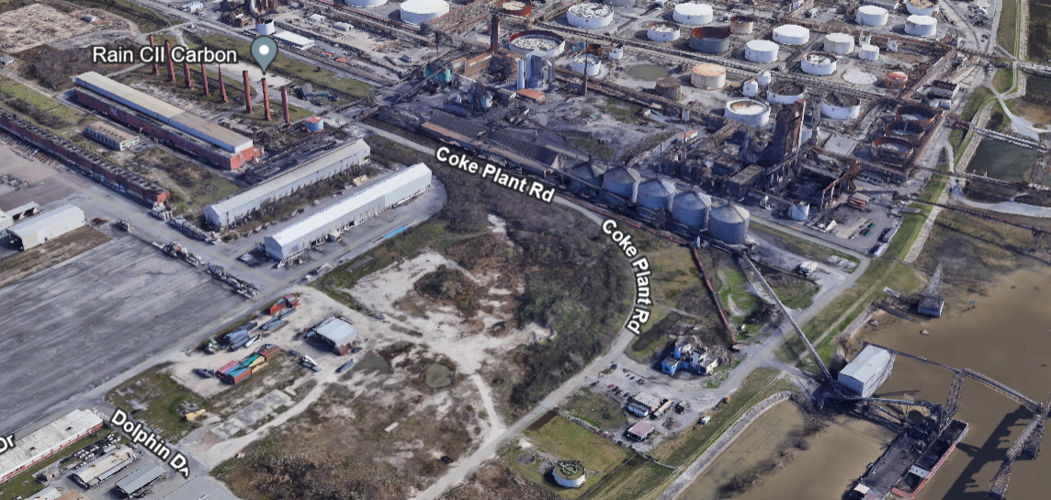A dozen Louisiana and national environmental groups are pressing the U.S. Environmental Protection Agency to set water pollution limits for the first time on a niche industry that processes crude oil refinery waste, alleging they discharge a host of toxic elements and chemicals in Louisiana and Texas waterways.
Two of those Louisiana groups — Healthy Gulf and Micah 6:8 Mission — also notified three of the processing plants, located in Gramercy and Calcasieu Parish, that they planned to sue them under the U.S. Clean Water Act over years of alleged discharges of toxic materials into the Mississippi, Blind and Calcasieu rivers, the notices say.
In a July report, one of the groups bringing the EPA petition, the Environmental Integrity Project, contended aging petroleum coke calcining plants exist in a longstanding gap of federal air and water pollution regulation. The situation has allowed the operations in Louisiana, Texas and other states to run with little oversight, the Integrity Project has contended.
"Petcoke processing plants have effectively been given a free pass to pollute our waters for the last 40 years," said Meg Parish, a senior attorney with the Environmental Integrity Project's Clean Water Program. "That needs to end."
Water discharges from some of the plants can be in the few pounds to less than a pound and sometimes even orders of magnitude smaller, EPA data show. Parish and others involved in the EPA petition contend the amounts are significant because of the elements' high toxicity and how long they last in the environment before breaking down.
An EPA spokesman said the agency was reviewing the petition, which is not a lawsuit but an administrative filing issued directly to the agency under the U.S. Clean Water Act and federal administrative rules. Should the agency agree to create the limits, the process could take several years and can consider technical feasibility, cost and water discharge amounts.
The petition was filed days before Tuesday's presidential election, which could shift the EPA's tougher stance on industrial regulation under the Biden administration.
Additional groups involved in the EPA petition are the Center for Biological Diversity, Environmental Law & Policy Center, Clean Water Action, Food & Water Watch, Habitat Recovery Project, RESTORE, Three Rivers Waterkeeper, Vessel Project of Louisiana and Waterkeeper Alliance.
Built between the 1930s and early 1980s, petcoke facilities put the remnants of crude oil refining into high-heat kilns and turn them into electrically conducive rock critical for the smelting of aluminum, steel and iron and the production of glass.
Known as "calcining," the process emits significant amounts of carbon dioxide, sulfur dioxide and other air pollutants, the groups say. It also leads to the discharge of process and stormwater runoff laden with a variety of heavy metals and a class of carcinogens known as polyaromatic hydrocarbons, or PAHs, according to the groups.
Seven of the nation's 13 petcoke calcining plants are in Louisiana, the groups say. They are often near poor and minority communities in heavily industrialized areas.
Among them are the Rain CII facilities in Gramercy, Chalmette, Norco and Sulphur; the Oxbow Calcining facility in Baton Rouge; and Alcoa's Reynolds plant in Lake Charles.
In the petition to the EPA, the groups want the agency to set new national industry specific water discharge limits on the variety of heavy metals and other chemicals they say can be discharged, among them lead, mercury, nickel, benzo(ghi)perylene, PAHs and vanadium.
The groups say these releases have been reported to the EPA. Also, their own examination of air and water discharge permits has tracked the flow of stormwater and process water to local waterways, they say.
Yet, in Louisiana, four of the seven facilities have no water discharge limits nor monitoring requirements for toxic pollutants, the groups told the EPA. Those four are the Rain CII plants in Gramercy and Chalmette, Oxbow Calcining in Baton Rouge and Reynolds Alcoa in Lake Charles. A fifth, Rain CII's plant in Sulphur, has toxic chemical limits and monitoring requirements only for chromium and zinc.
Parish, the integrity project lawyer, said the groups plan to sue the Rain CII plants in Gramercy and Sulphur and the Alcoa plant in Lake Charles because they each reported annual toxic water discharges to EPA but told the state Department of Environmental Quality they did not discharge those same pollutants when the agency was forming the companies' water permits.
Andrew Whitehurst, Healthy Gulf's water programs director, said DEQ needs to protect state waterways better "and hold these facilities accountable for the pollution they discharge."
The Rain CII plant in Gramercy reported to EPA water discharges of lead, nickel, PAHs and benzo(ghi)perylene over much of the past five years. None were above 13.5 pounds per year. The company's latest state water discharge permit, approved last year, doesn't set limits nor require monitoring of any of those chemicals.
Most of the water discharges pass through the company's settling ponds and a few miles of canals before whatever pollutants might be left winds up in the Blind River. Some petcoke barge runoff filtered outside that system ends up in the Mississippi, however, regulatory documents say.
DEQ, Rain CII and Oxbow Calcining officials didn't respond to a request for comment. Alcoa said it could not comment on potential litigation.
"Alcoa is committed to operating in compliance with all applicable legal requirements," it said in a statement.


